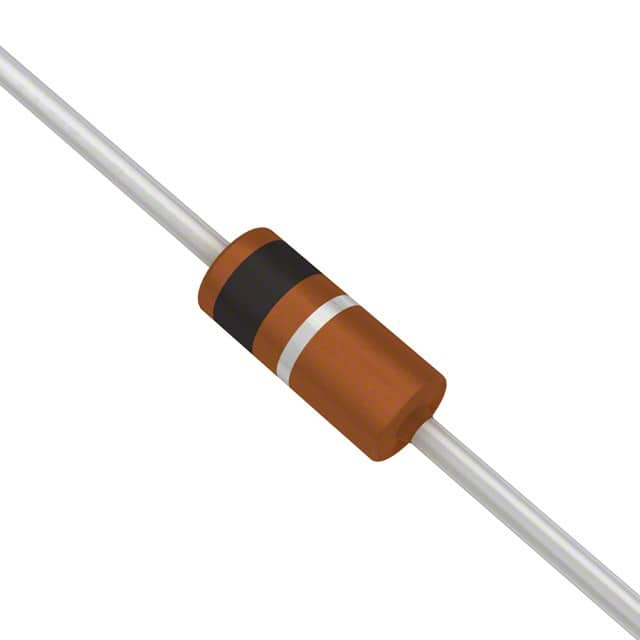Xem thông số kỹ thuật để biết chi tiết sản phẩm.

1N5228C-TR
Product Overview
The 1N5228C-TR belongs to the category of Zener diodes, which are widely used in electronic circuits for voltage regulation and protection. These diodes exhibit specific characteristics that make them suitable for various applications. The 1N5228C-TR is commonly used in power supplies, voltage regulators, and surge suppressors due to its unique properties.
Basic Information
- Category: Zener Diode
- Use: Voltage regulation and protection
- Characteristics: Sharp breakdown voltage, low dynamic impedance
- Package: DO-35
- Essence: Regulating voltage in electronic circuits
- Packaging/Quantity: Available in reels or bulk packaging
Specifications
- Voltage - Zener (Nom) (Vz): 3.3V
- Power - Max: 500mW
- Impedance (Max) (Zzt): 20 Ohm
- Current - Reverse Leakage @ Vr: 100nA
- Operating Temperature: -65°C ~ 200°C
Detailed Pin Configuration
The 1N5228C-TR Zener diode has two pins, with the cathode marked by a band on the body of the diode. The pin configuration is as follows: - Pin 1: Anode - Pin 2: Cathode
Functional Features
The 1N5228C-TR Zener diode provides precise voltage regulation and protection against voltage spikes. It exhibits a sharp breakdown voltage and low dynamic impedance, making it ideal for stabilizing voltage in electronic circuits.
Advantages and Disadvantages
Advantages
- Precise voltage regulation
- Protection against voltage surges
- Compact size
- Low dynamic impedance
Disadvantages
- Limited power dissipation capability
- Sensitive to temperature variations
Working Principles
When the voltage across the 1N5228C-TR Zener diode reaches its breakdown voltage, it starts conducting in the reverse direction, effectively regulating the voltage across the circuit. This characteristic makes it an essential component in voltage regulation and protection circuits.
Detailed Application Field Plans
The 1N5228C-TR Zener diode finds extensive use in various electronic applications, including: - Power supply units - Voltage regulators - Surge suppressors - Signal clamping circuits - Overvoltage protection circuits
Detailed and Complete Alternative Models
Some alternative models to the 1N5228C-TR Zener diode include: - 1N5221B-TR - 1N5222B-TR - 1N5223B-TR - 1N5224B-TR - 1N5225B-TR
In conclusion, the 1N5228C-TR Zener diode is a crucial component in electronic circuits, providing precise voltage regulation and protection against voltage spikes. Its unique characteristics and compact size make it suitable for a wide range of applications in the electronics industry.
Word Count: 410
Liệt kê 10 câu hỏi và câu trả lời thường gặp liên quan đến ứng dụng 1N5228C-TR trong giải pháp kỹ thuật
Sure, here are 10 common questions and answers related to the application of 1N5228C-TR:
What is the voltage rating of 1N5228C-TR?
- The voltage rating of 1N5228C-TR is 3.3V.
What is the maximum current that 1N5228C-TR can handle?
- The maximum current for 1N5228C-TR is typically around 500mA.
Can 1N5228C-TR be used for voltage regulation in power supplies?
- Yes, 1N5228C-TR can be used as a voltage regulator in low-power applications.
What is the typical forward voltage drop of 1N5228C-TR?
- The typical forward voltage drop of 1N5228C-TR is around 0.9V.
Is 1N5228C-TR suitable for overvoltage protection?
- Yes, 1N5228C-TR can be used for overvoltage protection in certain circuits.
What is the temperature range for 1N5228C-TR?
- The operating temperature range for 1N5228C-TR is typically -65°C to +200°C.
Can 1N5228C-TR be used in automotive electronics?
- Yes, 1N5228C-TR is suitable for use in automotive electronics due to its temperature range and voltage rating.
Does 1N5228C-TR require a heat sink for certain applications?
- In high-power applications, it is recommended to use a heat sink with 1N5228C-TR to dissipate heat effectively.
What are the typical applications of 1N5228C-TR?
- Typical applications include voltage regulation, overvoltage protection, and general purpose diode applications.
Is 1N5228C-TR suitable for use in battery charging circuits?
- Yes, 1N5228C-TR can be used in battery charging circuits for voltage regulation and protection.
I hope these questions and answers are helpful for your technical solutions! Let me know if you need further assistance.

